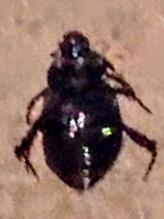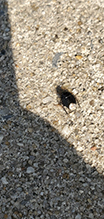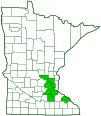peanut burrowing bug
(Pangaeus bilineatus)
Conservation • Description • Habitat • Ecology • Distribution • Taxonomy
|
|
||||||||||||||
Description |
Peanut burrowing bug, also called two-lined burrowing bug, is a small, common but seldom seen true bug. It occurs in North America and Central America. In the United States it occurs from Maine to Florida, west to Minnesota and southern California. Adults and nymphs feed on a variety of species and tissue types (polyphagous). They are a serious economic pest for farmers in the southern United States. They have been reported feeding on several crops, including peanut seeds, cotton seedlings, newly sprouted wheat, pepper seeds, spinach seedlings, and strawberry fruit. They are difficult to detect in the field because they spend most of their lives in the soil. The body is broadly oval, widest beyond the middle, and 3⁄16″ to 5⁄16″ (5.3 to 7.8 mm) in length. When it first emerges above ground, a young adult is light brown in color. As it ages it gradually darkens. Mature adults are black, shiny, hairless, and densely dotted with small pits (punctate). The head is small, wider than long, and much narrower than the thorax. It is tucked into a concave groove in the margin of the pronotum. It is not strongly convex, and the surface is not strongly wrinkled (rugose). There is no visible “neck” when viewed from above. There are two large, bulging, compound eyes and two small simple eyes (ocelli). The mouth parts are optimized for piercing and sucking. The antennae are black to brownish-yellow and have five segments. The exoskeletal plate covering the thorax (pronotum) is slightly more than half as long as it is wide. It is entirely black. The front lateral margins have a submarginal row of fine punctures. The sharply impressed transverse groove near the middle, present on most Pangaeus species, is poorly developed or absent. It is sometimes represented by a row of distinct punctures, but those too may be absent. There are two pairs of wings, and they are held flat over the body when at rest. Between the wing bases there is a triangular plate (scutellum). The forewings (hemelytra) are as long as the abdomen and completely cover the sides of the abdomen. They have a thickened section at the base and a thin membranous section at the tip with a clear dividing line between the two. The thickened basal part is comprised of a narrow area (clavus) behind the scutellum when the wings are closed, and the remaining broad marginal area (corium). The scutellum is triangular and large. It covers about half of the abdomen, but is not longer than the corium, and does not reach the tip of the abdomen. The clavi do not meet behind the scutellum. The corium is leathery brown. The membranous section extends beyond the tip of the abdomen. The hindwings are thin, membranous, and completely concealed beneath the forewings. The legs are moderately long and mostly black. The fourth segment (tibia) on the hind legs is armed with three rows of strong spines. The last part of each leg (tarsus), corresponding to the foot, is brownish-yellow and has three segments. The second segment is shorter and thinner than the first and third segments. On the front pair of legs, the tarsus arises at the tip of the tibia. |
Size |
Total length: 3⁄16″ to 5⁄16″ (5.3 to 7.8 mm) |
Similar Species |
Habitat |
|
Ecology |
Season |
April to September in the north. At least three generations per year in the south. |
Behavior |
|
Life Cycle |
Adults overwinter 6″ to 8″ (15 to 20 cm) deep in the soil. Eggs are laid in the soil. Larvae pass through five stages (instars) before emerging (eclosing) as an adult. Newly molted adults remain in the soil until their exoskeleton hardens. |
Larva Food |
A wide variety of plants |
Adult Food |
A wide variety of plants |
Distribution |
||
|
Sources |
|
Occurrence |
||
|
||
Taxonomy |
|
Order |
Hemiptera (True bugs, Hoppers, Aphids, and Allies) |
Suborder |
Heteroptera (True Bugs) |
Infraorder |
Pentatomomorpha |
Superfamily |
Pentatomoidea (stink bugs, shield bugs, and allies) |
Family |
Cydnidae (burrowing bugs) |
Subfamily |
Cydninae |
Tribe |
Geotomini |
Genus |
Pangaeus |
This species was originally described as Cydnus bilineatus in 1824. In 1862 it was moved to the genus Pangaeus. |
|
Subordinate Taxa |
|
|
|
Synonyms |
|
Pangaeus douglasi Pangaeus fortis Pangaeus scotti Pangaeus spangbergi Pangaeus uhleri Pangaeus vicinus |
|
Common Names |
|
peanut burrower bug peanut burrowing bug two-lined burrowing bug |
|
Glossary
Clavus
On Hemiptera: The hard part of the forewing that is adjacent to the scutellum when the wings are closed. Plural: clavi.
Corium
The thickened basal portion of the front wing that lies between the clavus and the membrane of insects in the family Hemiptera. Plural: coria.
Hemelytron
The forewing of true bugs (order Hemiptera), thickened at the base and membranous at the tip. Plural: hemelytra.
Ocellus
Simple eye; an eye with a single lens. Plural: ocelli.
Pronotum
The exoskeletal plate on the upper side of the first segment of the thorax of an insect.
Punctate
Dotted with pits (punctures), translucent sunken glands, or colored spots of pigment.
Tarsus
On insects, the last two to five subdivisions of the leg, attached to the tibia; the foot. On spiders, the last segment of the leg. Plural: tarsi.
Tibia
The fourth segment of an insect leg, after the femur and before the tarsus (foot). The fifth segment of a spider leg or palp. Plural: tibiae.
Visitor Photos |
||
Share your photo of this insect. |
||
This button not working for you? |
||
Faye Kalat |
||
 |
|
|
NewlyBugged |
||
 |
|
|
MinnesotaSeasons.com Photos |
||
|
||
|
||

Slideshows |
|

Visitor Videos |
||
Share your video of this insect. |
||
This button not working for you? |
||
|
Other Videos |
||
Pangaeus bilineatus Say, 1825 |
About
May 3, 2023 Pangaeus (Homaloporus) bilineatus Say,of the family Cydnidae,insect, also called "peanut digger insect", parasite that destroys the cultivation of peanuts, similar to the bug (also the smell it releases) but with the legs covered with bristly hairs, semi-circular head, the colors range from white to brown then glossy black. size 6/8 mm, origins from Central America, the Caribbean |

Created: 9/26/2023 Last Updated: © MinnesotaSeasons.com. All rights reserved. |

